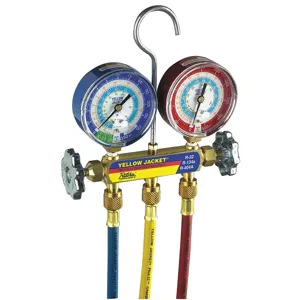YELLOW JACKET 42006 mechanical manifold is ideal for precise monitoring & regulation of pressure in refrigeration applications. It is used in HVAC, refrigeration and air conditioning applications. This manifold allows technicians to measure, evacuate & charge refrigerants accurately.
Features:
- This UL-listed manifold has full porting designed to maximise capacity and flow and features colour-coded scales for effortless identification.
- It is made with forged brass to ensure robust construction for lasting performance.
- This manifold incorporates sliding double O ring pistons, effectively minimising wear and has nylon seats to extend durability.
Frequently Asked Questions:
Q. How do I clean and maintain this YELLOW JACKET manifold?
A.
- Perform regular visual inspections for any signs of dirt, debris or damage.
- Wipe external surfaces with a clean, damp cloth to remove dirt and dust.
- Check hoses and fittings for wear or damage. Replace any damaged components promptly.
- If necessary, use a mild detergent solution to clean stubborn stains on external surfaces. Ensure thorough rinsing afterwards.
- Avoid using harsh chemicals or solvents that may damage the manifold's components.
- Store the manifold in a clean, dry place when not in use and protect it from extreme temperatures.
- Adhere strictly to the cleaning and maintenance guidelines provided in the manufacturer's user manual.
- Regularly inspect O-rings and seals for signs of wear or damage. Replace them if necessary to maintain a proper seal.
Q. What are the factors to consider while choosing a manifold?
A.
- Pressure ratings
- Construction materials
- Features
- Hose length
- Refrigerant compatibility
- Temperature range
Q. What safety precautions should I take when installing this mechanical manifold?
A.
- Use appropriate personal protective equipment, including safety glasses and gloves.
- Ensure that the equipment you are connecting the manifold to is turned off before installation.
- Check that the manifold is compatible with the refrigerants and pressures associated with your HVAC/R system.
- Inspect the manifold, hoses and fittings for any visible damage or defects before installation.
- Make sure all connections are secure and properly tightened to prevent leaks.
- Ensure that hoses and components are clean and dedicated to specific refrigerants.
- Use appropriate tools for installation and do not force connections.
- If the system is under pressure, release it safely before connecting the manifold.
- Follow the correct sequence of steps outlined in the installation manual to ensure proper installation.
- Inspect seals and O-rings for wear & damage and replace them if needed.
- Bleed air from the manifold and hoses before connecting to the system to prevent air pockets.
- Avoid over-tightening fittings, which can damage threads and seals.
- After installation, perform a leak check to ensure there are no refrigerant leaks.




